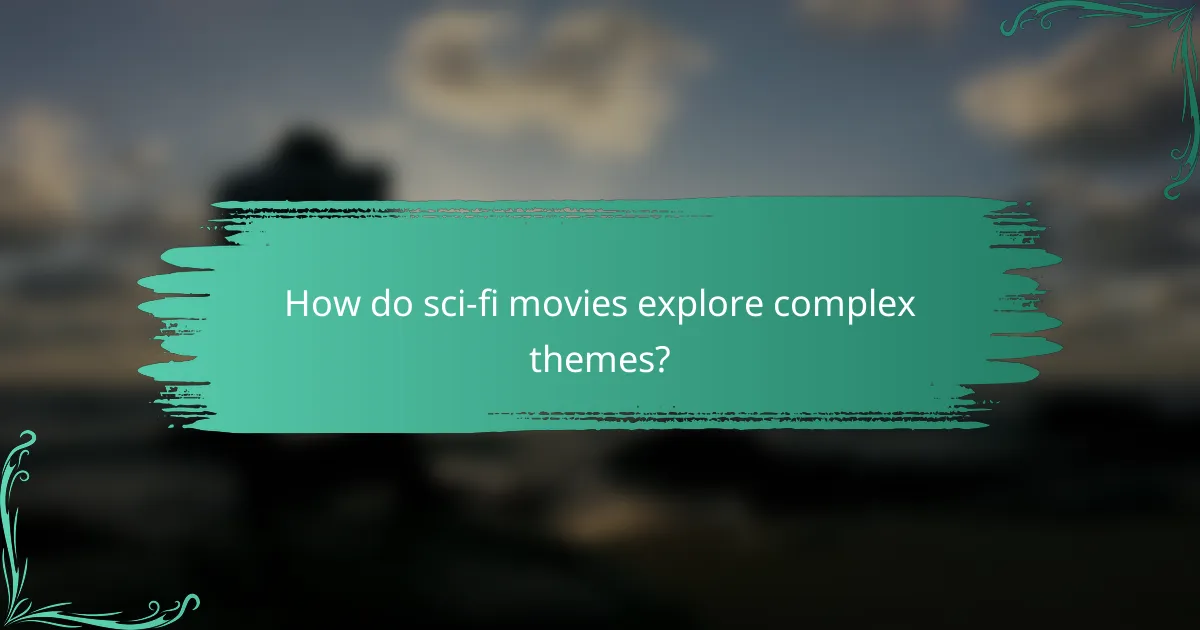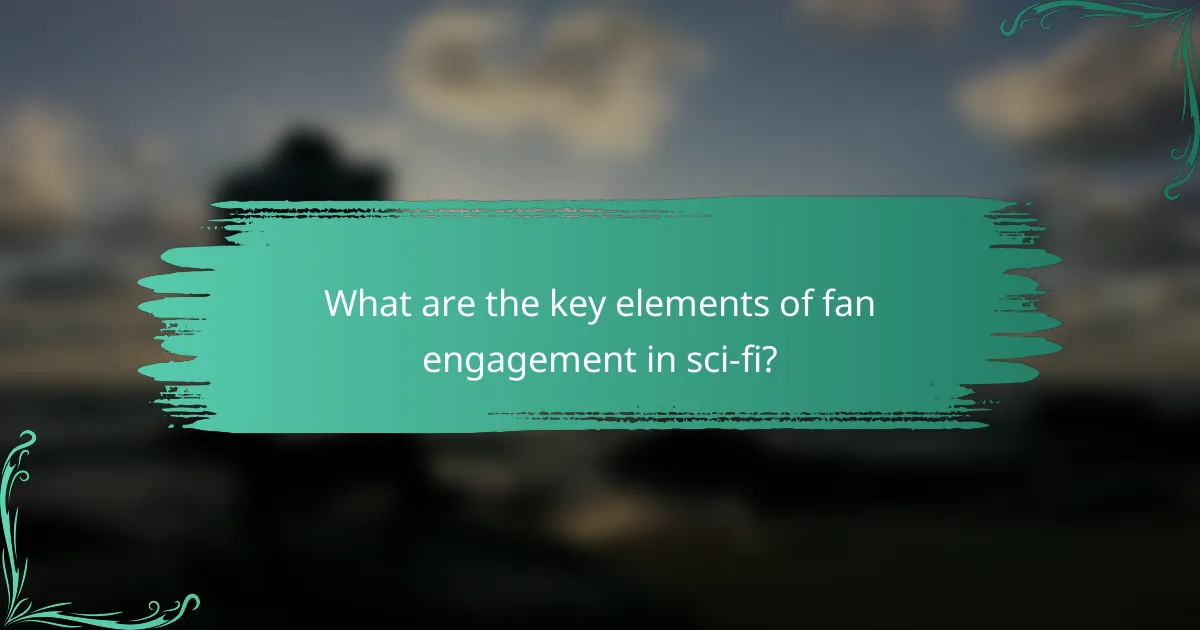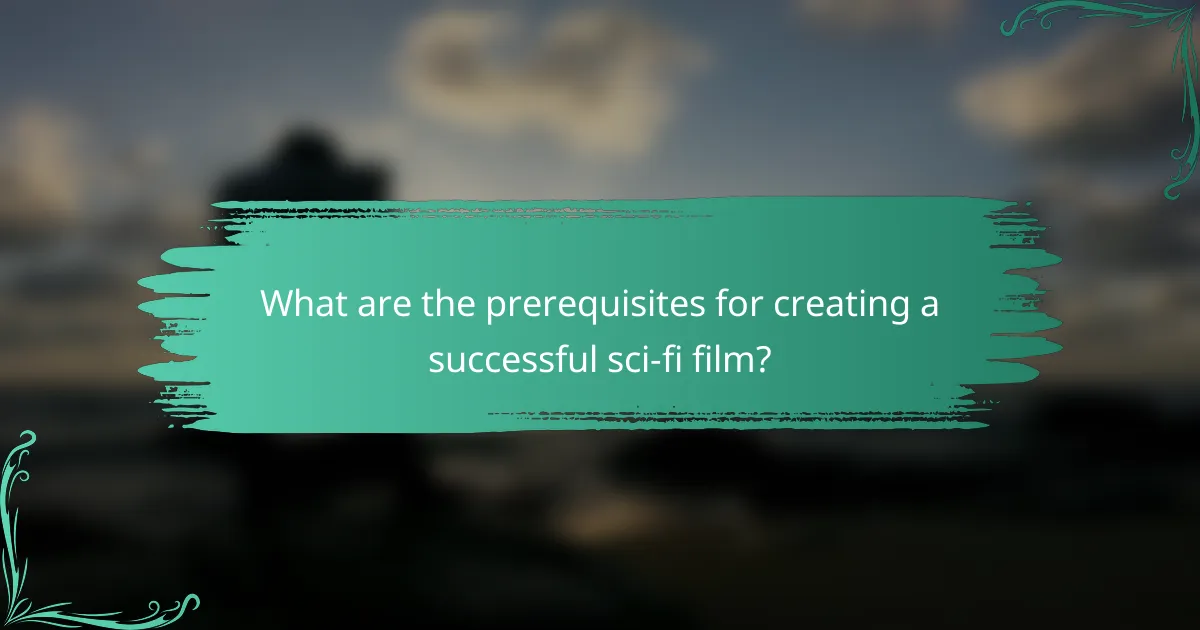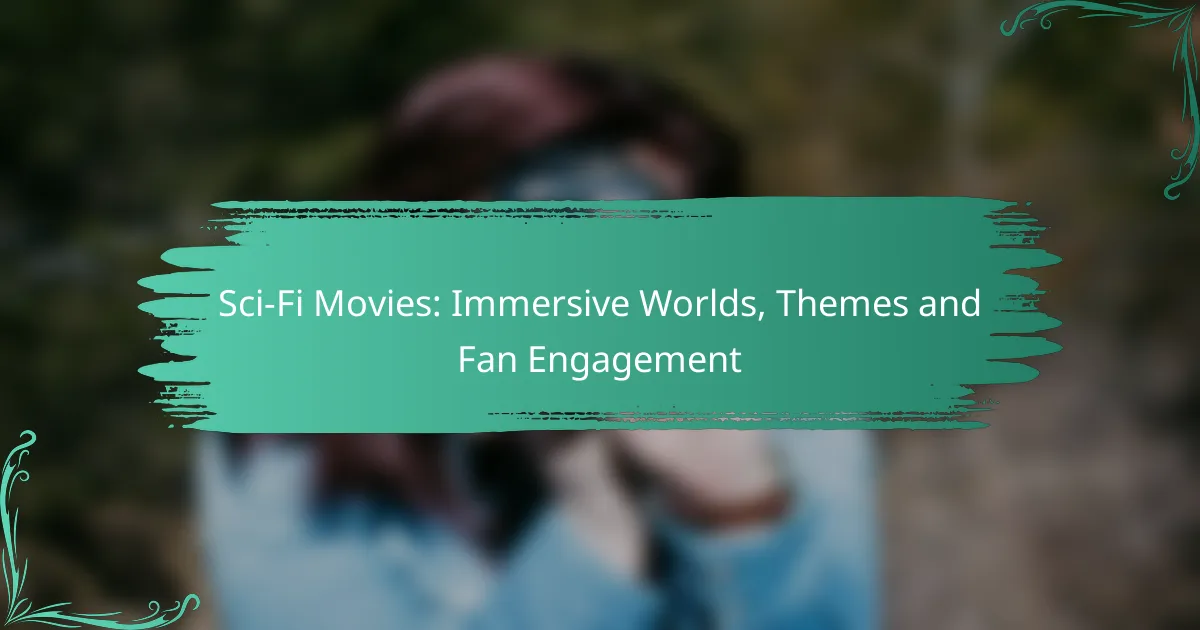Sci-fi movies are renowned for their ability to immerse viewers in captivating worlds that blend stunning visuals with intricate storytelling. By exploring complex themes through imaginative narratives, these films reflect on societal issues and human nature, inviting audiences to engage with philosophical questions. Additionally, the genre fosters strong fan engagement through interactive experiences and community building, allowing enthusiasts to express their creativity and connect with one another.

What are the best sci-fi movies for immersive worlds?
The best sci-fi movies for immersive worlds transport viewers into richly detailed settings that feel both believable and captivating. These films often blend stunning visuals, intricate storytelling, and thought-provoking themes to create experiences that resonate with audiences.
Blade Runner 2049
Blade Runner 2049 is a sequel that expands on the original’s dystopian universe, showcasing a visually stunning landscape filled with neon lights and desolate environments. The film explores themes of identity and humanity, inviting viewers to ponder the implications of artificial intelligence.
The attention to detail in the set design and cinematography creates an immersive experience, making the viewer feel as if they are walking through a future Los Angeles. The atmospheric score further enhances the emotional depth of the narrative.
Inception
Inception delves into the concept of dreams within dreams, crafting a complex narrative that challenges perceptions of reality. The film’s layered storytelling and innovative visual effects create a mind-bending experience that keeps audiences engaged.
Key scenes, such as the gravity-defying fight sequences and the shifting landscapes, exemplify how immersive worlds can be built through creative cinematography. The film encourages viewers to question the nature of their own realities.
Dune
Dune transports viewers to the desert planet of Arrakis, where political intrigue and ecological themes intertwine. The film’s grand scale and meticulous world-building immerse audiences in a universe filled with unique cultures and complex characters.
The stunning visuals, combined with a powerful score, enhance the experience of navigating this intricate world. Dune’s exploration of themes like resource scarcity and survival resonates with contemporary issues, making it relevant and thought-provoking.
The Matrix
The Matrix presents a simulated reality where humanity is unknowingly trapped, offering a unique take on the concept of virtual worlds. Its groundbreaking special effects and action sequences create an engaging and immersive experience.
The film’s philosophical undertones challenge viewers to consider the nature of reality and free will. The iconic visual style and memorable characters contribute to its status as a landmark in sci-fi cinema.
Interstellar
Interstellar explores the vastness of space and the complexities of time travel, creating an immersive experience that captivates audiences. The film combines scientific concepts with emotional storytelling, making the journey through space feel both thrilling and poignant.
Visually stunning depictions of black holes and distant planets enhance the sense of wonder. The film’s exploration of love, sacrifice, and humanity’s future adds depth, encouraging viewers to reflect on their place in the universe.

How do sci-fi movies explore complex themes?
Sci-fi movies delve into complex themes by using imaginative narratives and futuristic settings to reflect on societal issues, human nature, and philosophical questions. These films often serve as a lens through which audiences can examine contemporary concerns in a speculative context.
Artificial Intelligence
Artificial intelligence (AI) is a prevalent theme in sci-fi films, exploring the implications of creating sentient machines. These narratives often raise questions about ethics, autonomy, and the potential consequences of AI surpassing human intelligence.
Films like “Ex Machina” and “Blade Runner” illustrate the tension between human creators and their creations, prompting viewers to consider the moral responsibilities involved. As AI technology advances, these themes become increasingly relevant, reflecting real-world debates about regulation and ethical guidelines.
Time Travel
Time travel serves as a fascinating plot device in sci-fi, allowing characters to navigate different eras and alter events. This theme often explores the consequences of changing the past or future, raising questions about fate and free will.
Movies such as “Back to the Future” and “Looper” highlight the complexities of time travel, including paradoxes and alternate realities. These narratives encourage audiences to think critically about the nature of time and the impact of their choices on the timeline.
Existentialism
Existentialism is a recurring theme in sci-fi, focusing on the search for meaning in an often chaotic universe. Characters frequently grapple with their identity, purpose, and the nature of existence, reflecting deep philosophical inquiries.

What are the key elements of fan engagement in sci-fi?
Key elements of fan engagement in sci-fi include interactive experiences, community building, and creative expression. Fans actively participate through conventions, online platforms, and by creating their own content, which fosters a strong sense of belonging and shared enthusiasm for the genre.
Conventions and Festivals
Conventions and festivals serve as major gathering points for sci-fi fans, offering a space to celebrate their favorite franchises. Events like Comic-Con and Dragon Con feature panels, screenings, and meet-and-greets with creators and actors, enhancing the immersive experience.
Attending these events allows fans to connect with like-minded individuals, share their passion, and participate in cosplay. Many conventions also host workshops and discussions that deepen fans’ understanding of the genre and its themes.
Online Communities
Online communities play a crucial role in fan engagement, providing platforms for discussion and collaboration. Websites like Reddit, forums, and social media groups allow fans to share theories, news, and fan-created content, fostering a sense of camaraderie.
These communities often organize virtual events, such as watch parties or live discussions, which can enhance the viewing experience of new releases. Engaging in these spaces helps fans feel connected to the broader sci-fi community, regardless of geographical location.
Fan Art and Fan Fiction
Fan art and fan fiction are significant forms of creative expression that allow fans to explore and expand upon their favorite sci-fi universes. Artists and writers create original works that reflect their interpretations of characters and storylines, contributing to the richness of the genre.
Platforms like DeviantArt and Archive of Our Own provide spaces for fans to share their creations, receive feedback, and connect with others who appreciate their work. This creative engagement not only showcases talent but also deepens fans’ emotional investment in the stories they love.

How do sci-fi films influence popular culture?
Sci-fi films significantly shape popular culture by introducing innovative concepts and futuristic ideas that resonate with audiences. These movies often inspire trends in technology, fashion, and social movements, reflecting and sometimes predicting societal changes.
Merchandising Trends
Merchandising in the sci-fi genre has become a multi-billion dollar industry, driven by fan engagement and the popularity of franchises. Action figures, collectibles, and themed apparel are common, with limited editions often selling out quickly. Brands frequently collaborate with studios to create exclusive products that appeal to dedicated fans.
For example, the success of franchises like “Star Wars” and “Star Trek” has led to a wide range of merchandise, from toys to home decor. Fans often seek out unique items, making conventions and online marketplaces popular venues for buying and selling collectibles.
Fashion and Design
Sci-fi films have a profound impact on fashion and design, influencing everything from clothing styles to interior decor. Designers often draw inspiration from the futuristic aesthetics seen in films, incorporating bold colors, innovative materials, and unconventional silhouettes into their collections.
Notable examples include the influence of “Blade Runner” on urban fashion and the sleek designs of “The Matrix” that have permeated mainstream clothing. Additionally, sci-fi themes often appear in home design, with futuristic furniture and decor reflecting the imaginative worlds depicted in films.

What are the prerequisites for creating a successful sci-fi film?
Creating a successful sci-fi film requires a combination of strong world-building, compelling character development, and engaging themes that resonate with audiences. These elements work together to immerse viewers in a believable yet imaginative universe.
Strong World-Building
Strong world-building is essential for establishing the setting and rules of the sci-fi universe. It involves creating a detailed and coherent environment that feels authentic, whether it’s a distant planet, a futuristic city, or an alternate reality. Filmmakers should consider the history, culture, and technology of their world to make it relatable and intriguing.
To achieve effective world-building, filmmakers can use visual storytelling, detailed production design, and consistent lore. For instance, the use of unique languages, customs, and technologies can enhance the depth of the world. A well-defined set of rules, such as how technology operates or the laws of physics in that universe, helps maintain audience suspension of disbelief.
Character Development
Character development is crucial for connecting viewers emotionally to the story. Well-developed characters should have clear motivations, distinct personalities, and arcs that evolve throughout the film. Audiences are more likely to engage with characters who face relatable challenges or moral dilemmas, making their journey compelling.
Filmmakers should focus on creating diverse character backgrounds and relationships that reflect the complexities of human experience. Techniques such as backstory integration, dialogue that reveals character traits, and dynamic interactions can enhance character depth. Avoiding clichés and ensuring characters grow in response to their experiences can lead to a more satisfying narrative.
